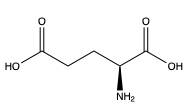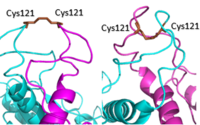Sandbox Reserved 1715
From Proteopedia
(Difference between revisions)
| Line 31: | Line 31: | ||
|} | |} | ||
| - | [[Image:Screen Shot 2022-03-28 at 8.44.00 AM.png|300 px|right|thumb|Figure | + | [[Image:Screen Shot 2022-03-28 at 8.44.00 AM.png|300 px|right|thumb|Figure 2. Structure of glutamate. ]]In order to activate the mGlu transformation, glutamate acts as the protein’s main agonist. Glutamate is an acidic, polar amino acid. (picture) This agonist binds to the extracellular portion of the protein allowing the homodimer to change conformationally. This change allows for a signaling cascade within the cell that can ultimately lead to the modification of other proteins and a difference in the synapse’s excitability. However, in mGlu, the binding affinity of glutamate is determined by either a positive (PAM) or negative (NAM) allosteric modulator. |
== Structural Highlights == | == Structural Highlights == | ||
mGlu receptors are dimeric proteins consisting of an <scene name='90/904320/Inactive_mglu2/1'>alpha and beta chain</scene>. While a heterodimer of different mGlu subtypes can form, only homodimeric receptors can become active. Both the alpha and beta chains are comprised of <scene name='90/904320/Mglu2_domains/2'>3 domains</scene>: the venus fly trap (VFT), cysteine rich domain (CRD), and the transmembrane domain (TMD). | mGlu receptors are dimeric proteins consisting of an <scene name='90/904320/Inactive_mglu2/1'>alpha and beta chain</scene>. While a heterodimer of different mGlu subtypes can form, only homodimeric receptors can become active. Both the alpha and beta chains are comprised of <scene name='90/904320/Mglu2_domains/2'>3 domains</scene>: the venus fly trap (VFT), cysteine rich domain (CRD), and the transmembrane domain (TMD). | ||
| Line 45: | Line 45: | ||
== Conformational Changes == | == Conformational Changes == | ||
| - | '''1.''' mGlu starts in an <scene name='90/904320/Inactive_mglu/2'>inactive homodimeric form</scene>. In this conformation, the receptor is considered open with an inter-lobe angle of 44 degrees.The structure has two free binding sites in the VFT, the CRDs are separated, and the TMD is not interacting with a G protein. [[Image: IMG 0144.jpg| | + | '''1.''' mGlu starts in an <scene name='90/904320/Inactive_mglu/2'>inactive homodimeric form</scene>. In this conformation, the receptor is considered open with an inter-lobe angle of 44 degrees.The structure has two free binding sites in the VFT, the CRDs are separated, and the TMD is not interacting with a G protein. [[Image: IMG 0144.jpg|450px|middle|thumb|Figure 3. Illustration of mGlu's conformational change process.]] |
'''2.''' In the intermediate activation state (known as the open-closed conformation), one glutamate is bound in one binding pocket of VFT. This <scene name='90/904320/Mglu_binding/4'>glutamate bound state</scene> is still considered inactive as the receptor has not changed the conformations in the CRD and thus the TMD. With the same asymmetric transmembrane helices formation, a TM3-TM4 interface is still present and mGlu cannot interact with a G protein. | '''2.''' In the intermediate activation state (known as the open-closed conformation), one glutamate is bound in one binding pocket of VFT. This <scene name='90/904320/Mglu_binding/4'>glutamate bound state</scene> is still considered inactive as the receptor has not changed the conformations in the CRD and thus the TMD. With the same asymmetric transmembrane helices formation, a TM3-TM4 interface is still present and mGlu cannot interact with a G protein. | ||
| - | '''3.''' A second glutamate binds to the other <scene name='90/904320/Active_site_interactions/3'>binding pocket</scene> of the VFT. Mediated by L639, F643, N735, W773, and F776, a <scene name='90/904319/Pam/1'>positive allosteric modulator</scene> (PAM) also binds within the seven TMD helices of the alpha chain. This closed conformation with an inter-lobe domain of 25 degrees is considered the active conformation. The binding of these ligands allows the CRD to compact and come together. This transformation causes the TMD to form another asymmetric conformation with a TM6-TM6 interface between the chains.[[Image: Protein Interaction with G Protein.png|200 px|right|thumb|Figure | + | '''3.''' A second glutamate binds to the other <scene name='90/904320/Active_site_interactions/3'>binding pocket</scene> of the VFT. Mediated by L639, F643, N735, W773, and F776, a <scene name='90/904319/Pam/1'>positive allosteric modulator</scene> (PAM) also binds within the seven TMD helices of the alpha chain. This closed conformation with an inter-lobe domain of 25 degrees is considered the active conformation. The binding of these ligands allows the CRD to compact and come together. This transformation causes the TMD to form another asymmetric conformation with a TM6-TM6 interface between the chains.[[Image: Protein Interaction with G Protein.png|200 px|right|thumb|Figure 4. The interaction between an active mGlu and a G-protein ]] |
'''4.''' The <scene name='90/904319/Active_helices/8'>crossover of the helices</scene> from the alpha and beta chains allows for intracellular loop 2 (ICL2) and the C-terminus to be properly ordered to interact with a G protein. While hydrogen bonding is present, this coupling is primarily driven by the hydrophobic interactions in the interface with the ɑ5 helix of the G protein (Figure 2). This <scene name='90/904320/Active_mglu/3'>mGlu/G-protein coupling</scene> can only occur in the presence of a PAM as the pocket in which the coupling occurs would be completely closed in its absence. | '''4.''' The <scene name='90/904319/Active_helices/8'>crossover of the helices</scene> from the alpha and beta chains allows for intracellular loop 2 (ICL2) and the C-terminus to be properly ordered to interact with a G protein. While hydrogen bonding is present, this coupling is primarily driven by the hydrophobic interactions in the interface with the ɑ5 helix of the G protein (Figure 2). This <scene name='90/904320/Active_mglu/3'>mGlu/G-protein coupling</scene> can only occur in the presence of a PAM as the pocket in which the coupling occurs would be completely closed in its absence. | ||
Revision as of 17:46, 28 March 2022
Metabotropic Glutamate Receptor
| |||||||||||
References
- ↑ 1.0 1.1 Ransey E, Paredes E, Dey SK, Das SR, Heroux A, Macbeth MR. Crystal structure of the Entamoeba histolytica RNA lariat debranching enzyme EhDbr1 reveals a catalytic Zn(2+) /Mn(2+) heterobinucleation. FEBS Lett. 2017 Jul;591(13):2003-2010. doi: 10.1002/1873-3468.12677. Epub 2017, Jun 14. PMID:28504306 doi:http://dx.doi.org/10.1002/1873-3468.12677
- ↑ 2.0 2.1 Seven AB, Barros-Alvarez X, de Lapeyriere M, Papasergi-Scott MM, Robertson MJ, Zhang C, Nwokonko RM, Gao Y, Meyerowitz JG, Rocher JP, Schelshorn D, Kobilka BK, Mathiesen JM, Skiniotis G. G-protein activation by a metabotropic glutamate receptor. Nature. 2021 Jun 30. pii: 10.1038/s41586-021-03680-3. doi:, 10.1038/s41586-021-03680-3. PMID:34194039 doi:http://dx.doi.org/10.1038/s41586-021-03680-3
Student Contributors
- Courtney Vennekotter
- Cade Chezem




